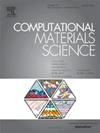Band gap transition characteristics for emission on (GeSn)n/Si superlattice
IF 3.3
3区 材料科学
Q2 MATERIALS SCIENCE, MULTIDISCIPLINARY
引用次数: 0
Abstract
Explorations in Group IV materials reveal the optic-electronic tunability enhanced in the GeSn/Si superlattices through synergistic controlling strain and quantum confinement effects, where the combination system of Ge nanolayer to produce pumping states and GeSn superlattices for generating emission states is built, positioning them as promising candidates for monolithically integrated silicon photonics. However, the fundamental mechanisms governing bandgap modulation and emission enhancement in these systems remain insufficient, primarily due to experimental challenges in achieving atomic-level periodicity control under metastable growth conditions. The Density Functional Theory (DFT) is used to perform first-principles calculations, in which the electronic structure of (GeSn)n/Si superlattice with less than 8 % Sn atom doping is systematically investigated, and the Ge/Si nanolayer without Sn atom doping for comparative analysis is calculated. The calculation results show that the direct band gap of (GeSn)n/Si superlattice (period n: 1 to 5) varies from 0.426 eV to 0.033 eV, and the direct band gap of Ge/Si nanolayer varies from 0.657 eV to 0.263 eV in the diameter variation range of 1.67 nm to 6.10 nm, which are originated from the quantum confinement effect and the tensile strain effect. Therefore, the computational insights establish a predictive framework for optimizing relevant experiments, which is conducive to realizing silicon-based light sources.

(GeSn)n/Si超晶格上发射的带隙跃迁特性
第四组材料的探索揭示了通过协同控制应变和量子约束效应增强GeSn/Si超晶格的光电可调性,其中构建了产生泵浦态的Ge纳米层和产生发射态的GeSn超晶格的组合系统,将其定位为单片集成硅光子学的有希望的候选材料。然而,在这些系统中控制带隙调制和发射增强的基本机制仍然不充分,主要是由于在亚稳态生长条件下实现原子水平周期性控制的实验挑战。利用密度泛函理论(DFT)进行第一性原理计算,系统地研究了Sn原子掺杂小于8%的(GeSn)n/Si超晶格的电子结构,并计算了不掺杂Sn原子的Ge/Si纳米层进行对比分析。计算结果表明,(GeSn)n/Si超晶格(周期n: 1 ~ 5)的直接带隙在0.426 ~ 0.033 eV之间变化,Ge/Si纳米层的直接带隙在0.657 ~ 0.263 eV之间变化,其直径变化范围为1.67 ~ 6.10 nm,这是由量子约束效应和拉伸应变效应引起的。因此,计算见解为优化相关实验建立了预测框架,有利于硅基光源的实现。
本文章由计算机程序翻译,如有差异,请以英文原文为准。
求助全文
约1分钟内获得全文
求助全文
来源期刊

Computational Materials Science
工程技术-材料科学:综合
CiteScore
6.50
自引率
6.10%
发文量
665
审稿时长
26 days
期刊介绍:
The goal of Computational Materials Science is to report on results that provide new or unique insights into, or significantly expand our understanding of, the properties of materials or phenomena associated with their design, synthesis, processing, characterization, and utilization. To be relevant to the journal, the results should be applied or applicable to specific material systems that are discussed within the submission.
 求助内容:
求助内容: 应助结果提醒方式:
应助结果提醒方式:


